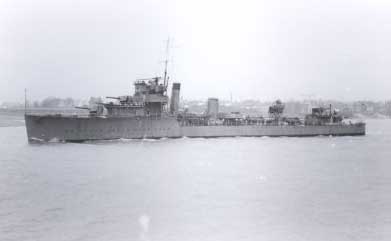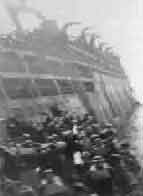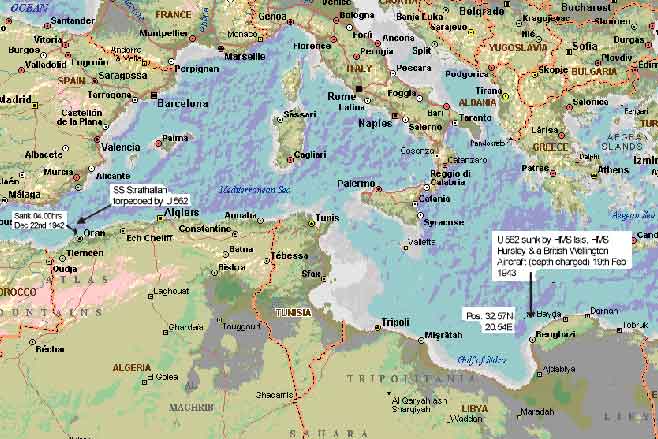SS Strathallan a 27,772 ton P and O ship, was build by Vickers Armstrong of Barrow to be completed in 1938. Designed for the UK/Australia run to carry some 448 First Class and 563 Tourist Class passengers.
The Countess of Cromer, the wife of a P and O Director performed the launching niceities on March 10th. 1938.
The ship commenced her maiden voyage from London to Brisbane on June 24th. 1938.

SS Strathallan
WW2.
Come WW2, the ship was requisitioned by the Ministry of Shipping on February 4th. 1940 to be fitted out as a Troop Transport.
Operation Torch.
Strathallan took part in Operation Torch, the Algerian landings in North Africa on November 1st. 1942. The following month she left the Clyde on the 12th. her destination Oran, having loaded 250 Queen Alexandra Nurses, and 4,000 British and US troops.
Torpedoed.
On the bright moonlit night of December 21st. 1942, having passed through the Straits of Gibraltar to enter the Mediterranean, U-Boat U-562 spotted her, and in the middle watch at 0025 ( 12.25 AM ) slipped a torpedo into her port side, it penetrated into the engine room, and two engineer officers and four crew members died.
List of Casualties from Strathallan
Compiled by Eric Smith.
|
Name
|
Date
|
Age
|
|
| Knox Norman - 3rd Engr |
21st Dec 1942
|
22
|
Son of John Thomas & Isabella of Chirton North Shields Northumberland |
| Morley Harry S - 3rd Engr Offr |
21st Dec 1942
|
41
|
Bombay - Chittagong Mem. |
| Brahim - Seaman |
21st Dec 1942
|
26
|
|
| Nizam Dil - Water Tender |
21st Dec 1942
|
43
|
|
| Saheb Dil - Oiler |
21st Dec 1942
|
43
|
|
| Muhammad Akbar - Lamp Trimmer |
21st Dec 1942
|
29
|
|
|
The destroyer HMS Verity took off the nurses and some 1,000 troops,

HMS Verity pre WW2
A second destroyer Laforey took the trooper under tow, with the salvage tug Restive assisting in the towing task.

HMS Laforey
It was hoped the stricken liner might be towed to the safe haven of Oran, but before that port could be reached, the increasing list, and the fire on board threatening to reach the deadly cargo of ammunition and rockets in the hold, made it imperative to rescue those still on board.

Strathallan on fire
The rest of the troops and crew members were taken off by destroyers including HMS Panther, and the tug Restive.

HMS Panther alongside Strathallan, rescuing survivors.
The ship finally sank in position 36 degrees 52 minutes North and 00 degrees 34 minutes West at 0400 ( 4 AM ) 12 miles short of Oran.

Map showing the position of Strathallan sinking,
and the subsequent position of the sinking of U-562 in 1943.
U-562, despatched.
The U-Boat was herself sunk in 1943 with the loss of all hands.
Margaret's Story of the sinking.
Margaret Bourke White.
Introduction by Life Magazine.
Last year Life assigned Miss Bourke-White to the US Air forces as the first woman photographer ever so accredited. She covered the Bomber Command in England (Life Oct 19… 1942), then in December boarded a Troopship bound for North Africa where she arrived just at the turn of the year. She arrived by destroyer, the Troopship having been torpedoed en route, and it is this experience which she tells on these pages.
Margaret Bourke-White Report.
“The torpedo did not make as loud a crash as expected, nor did the ship list as much as it does in the movies. But somehow everyone on the sleeping troop transport knew that this was the end of her. Tossed out of my upper bunk, I snapped on the light switch.The power had gone. I managed to find my flashlight and began a race for my clothes. I remember deciding whether to take the time to put on my belt and tie. I decided in favour of the belt and against the tie. Should I wear my great coat or trench coat. The trench coat was water proof but the greatcoat was warmer. I decided on the greatcoat.
"My two Scottish room mates were Nursing Sisters, so called not from any religious convictions but because they belonged to Queen Alexandra’s Military Nursing Reserve Service. Sister Ismay Cooper scrabbled through the bureau drawers for her money and Sister Violet MacMillan pulled on her trousers and tore the curlers out of her hair. Even in the faint flashlight beam I was impressed by the trousers. We had joked about them during the convoy voyage because the nursing sisters…. operating under “Old Battle Axe” their strict Scottish Matron….had been forbidden to wear slacks except for a torpedoing”
“When it came to choosing which of my six camera’s I should save I didn’t hesitate a second, for, I had worked that out carefully in advance. Instead of packing my musette bag with extra clothing as instructed, I had stored in it my Rolleiflex and a emergency film supply, together with one other camera, my favourite Linhof, and the five most valuable of its lenses. I put on my greatcoat, crammed my field cap into my pocket, slipped my life-belt over my shoulders, my helmet on my head and started up the companionway. Although it was only three minutes before we were out of our cabin. Everything seemed to be in slow motion. Up from the hold of the Transport came two orderly lines of troops, one filing toward the starboard side, the other the port side. Instead of going to my boat station Nox on “B” Deck, I raced up to a spot under the Bridge which I had selected beforehand. In case of enemy action I had arranged with the commanding officer to stay on deck and take pictures. As I reached the top flight of steps I was hoping dawn would come so that I could use my camera, but I came out under a night sky gleaming with moon and stars. “ Just like Jerry to do this at night” I said to myself.
"One of the crew came running over to send me to my boat station . But when I explained“ I am the Life Magazine Photographer” the reply was….”J….” X@&$3£ (or something like that.)
However……eventually I had to climb over the ships rail into the boat under the calm direction of “Old Battleaxe” I just had time to fall into my regular place which I had occupied during daily drill. In the Lifeboat I was astonished to find the water up to my hips. The torpedo splash had flooded the lifeboat on the port side aft. I hugged my cameras to my chest to keep them dry but as we made our quivering descent columns of water began pouring down on us from lifeboat No xx which was swinging above our heads. Its crew was pulling out plugs to empty the hull before lowering away. On our interminable descent I looked up to see the ships hull rising against cloud banks of pure silver “ If that were sun instead of moonlight on those clouds” I thought “ This would be the perfect sky”
"Just then the attention of all of us was caught by a heavy dangling chain which swung cruelly back and forth while we ducked and twisted our heads out of the way. We were in the water at last. The sea which from above had looked so calm, rose up against us wave after wave and began beating us back against the side of the ship. Our crew strained at the oars. There was so little space left in our crowded boat that we began singing, bending our bodies in rhythm to give the rowers room to move their arms. Just as we had created a margin between ourselves and the big ship, down came lifeboat No11 with its load of British sisters. Its crew had been unable to replace the plugs properly and it filled to the gunwales.
"A couple of dozen sisters were washed over the side. Some of them were carried immediately into their flooded boat on the next wave. Others started swimming towards rafts which were tossed from the upper decks. Helmets were used as bailing buckets.
"We tried to force our way to the swimmers but our rudder broke and we found ourselves drifting. All around nurses were in spasms of seasickness.
"Towards the stern still trying to free itself was a life boat. The big ship now, its great bulk in the moonlight was a network of ropes and ladders.”
Acknowledgement.
I acknowledge my debt to URL: http://www.thestrathallan.com/sinking.htm for the Map, two of the photographs and the account by Margaret.






